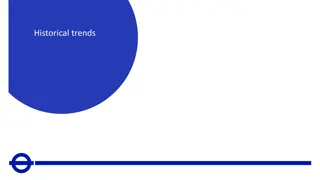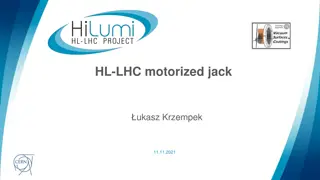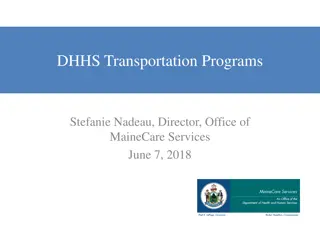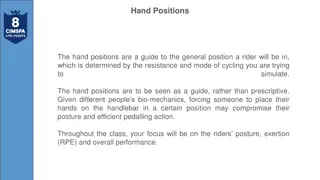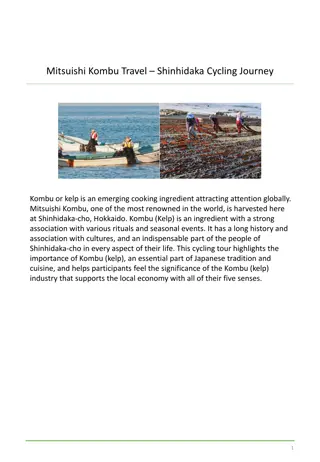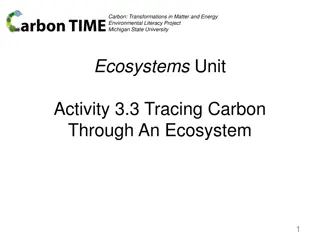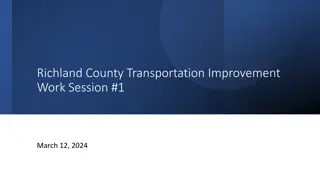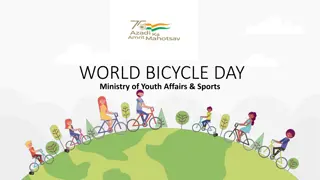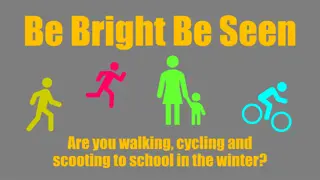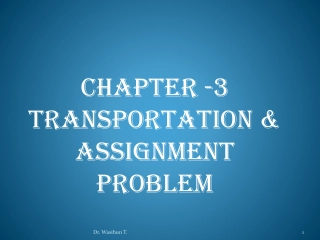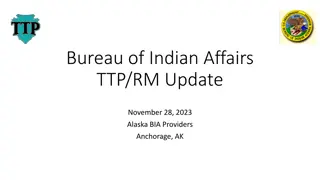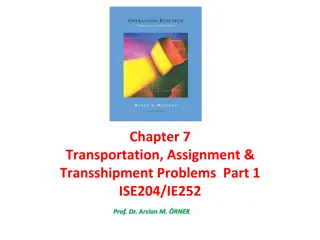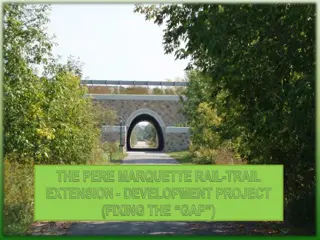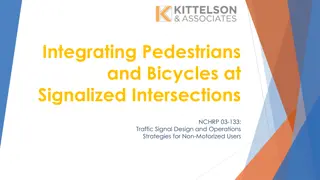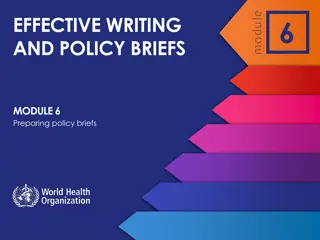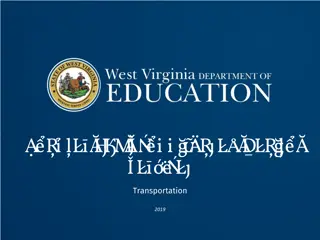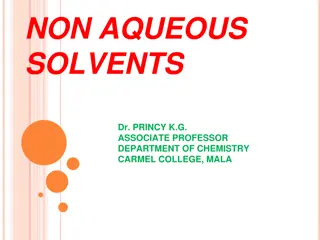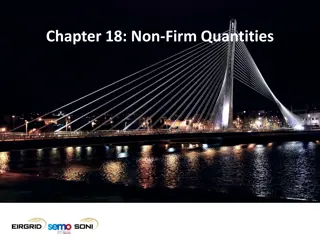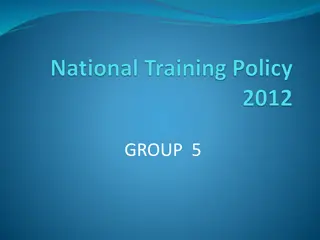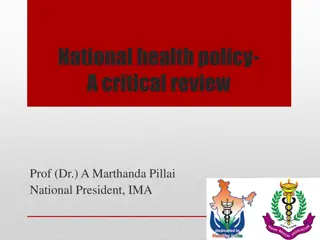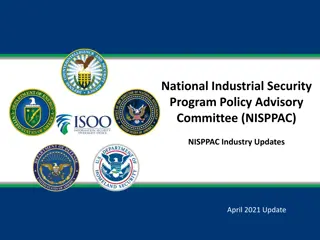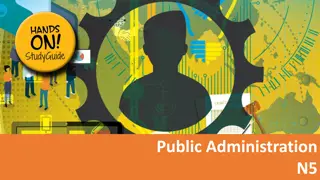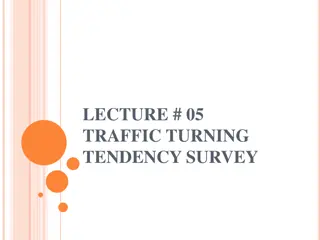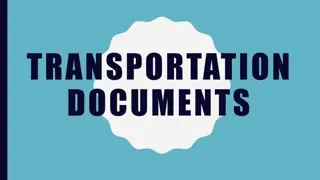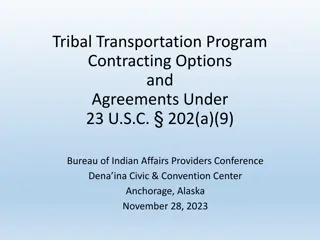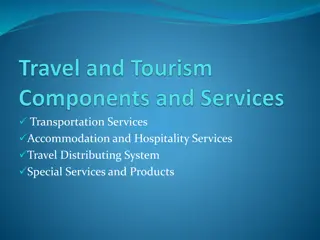Non-Motorized Transportation and National Cycling Policy
Introduction to the importance of non-motorized transportation, focusing on walking and cycling as key components in urban and rural settings. Discusses the prevalence of NMT in various countries, challenges faced, and the need for promoting NMT for sustainable transport systems. Highlights the creation of the Non-Motorized Transportation unit within FRSC and outlines the benefits and objectives of promoting NMT.
Download Presentation

Please find below an Image/Link to download the presentation.
The content on the website is provided AS IS for your information and personal use only. It may not be sold, licensed, or shared on other websites without obtaining consent from the author. Download presentation by click this link. If you encounter any issues during the download, it is possible that the publisher has removed the file from their server.
E N D
Presentation Transcript
NON-MOTORIZED TRANSPORTATION/ NATIONA L CYCLING POLICY
NON-MOTORIZED TRANSPORTATION/ NATIONAL CYCLING POLICY INTRODUCTION: Also known as active and human powered transportation, Non- Motorized Transport includes walking and cycling, and variant such as small wheeled transport (rick shaws, skates, skateboards, push scooter and hand carts) and wheelchair travel. Many urban residents in developing countries and emerging economies rely on cycling or walking but with economic growth , the Non-Motorized Transportation (NMT) share in transport system is threatened. In developing countries, cities like Japan, Germany and the Netherlands, 40-60 percent of all trips are made by walking and cycling, while similar cities in India, this share is as high as 80 percent. Almost all rural transport in Sub-Saharan Africa is non-motorized and dominated by head- and- back carrying by women and children. In many Asian countries, non-motorized (two- and- three wheelers ) are common sights, employing special adaptations to the vehicle for goods transport, hawking or passenger hire. Walking accounts for two thirds of total trips in large African cities such as Kinshasa and Dar es Salaam. In Karachi, walking and cycling account for 60 percent of total trips, and for 40 percent of work-related trips.
In Madras, one third of the vehicles entering the central business district are bicycles, as are 25 percent of the vehicles passing a Cordon line 10 miles from the center. In Kenya, more than 90 percent of rural trips are on foot, 4 percent by bicycle, 2 percent by Para transit and only 0.5 percent by bus. In most Chinese cities 50- 90 percent of vehicular passenger movements are by bicycle, with most of the remainder by bus. NMT has been adapted as a cost effective solution for such diverse purposes as trash disposal, ambulance services, agriculture produce transport and wholesale delivery.
AIM The aim of this paper is to highlight the benefits of non-motorized transportation and suggest the way forward. OBJECTIVES At the end of this lecture, participants should be able to: Define NMT. Understand the establishment of the NMT Unit in FRSC. Know the issues at stake, The Benefits and Challenges of NMT. FRSC efforts toward the improvement of NMT and the way forward.
DEFINATION OF TERMS Non-Motorized Transportation (NMT);Simply means- the movement of people, objects, animals, bicycles etc devoid of motor engine. It includes all means of transport that are human powered. THE NON-MOTORIZED TRANSPORT UNIT IN FRSC The Non Motorized Transportation unit was created by management in 2013 and domiciled in COSEN before it was finally moved to the Policy Section of Policy Research and Statistics Department of RSHQ Headquarters Abuja. The Unit was created to handle all the activities of the Corps on Non Motorized Transportation.It is imperative to note that the Non-Motorized Transportation (NMT) Unit being an emerging initiative of the Corps and an untapped national issue requires a blueprint to enable a meaningful impact. THE ISSUES AT STAKE The benefits to be derived from the implementation of the non motorized transportation are so numerous that one wonders why successive governments at all levels have failed to initiate programmes and actions that will bring cycling into spotlight as one of the effective alternative means of transportation in Nigeria.
According to the survey report of the technical Committee set up by the FRSC in 2011 to look into issues on non motorization, they discovered that the use of bicycle has been part of our transport system especially in our villages from the time of early civilization but has become almost nonexistent due to two (2) major reasons; Total absence of cycling infrastructure, law and safety programmes, Class attitude of most Nigerians. The question now is, how do we drive the NMT programme to succeed in Nigeria given the total lack or absence of infrastructural facilities for Non Motorized Transportation on Nigerian roads and general apathy on the part of the citizenry? To effectively achieve this mandate, the first step will be to promote cycling to such a level that it will reawaken the consciousness of people to making cycling a way of life. This requires a steady progress over time including strong political and public support. Change may be difficult at first but determined efforts will make a difference. This will be done in phases where individuals and groups will be brought to light on the benefit of non-motorized transport system in Nigeria.
BENEFITS OF NON-MOTORIZED TRANSPORTATION The use of non-motorized transportation also means that the carbon emissions released to the atmosphere by motorized vehicles are completely eliminated. Therefore the unquantifiable health implications arising from overconcentration of the hazardous gases in the atmosphere are reduced. The heavy reliance on motor vehicles has made Nigerian urban transportation system vulnerable in the case of increased oil prices. With the adoption of non motorized transportation, the National fuel consumption will be reduced.
The health benefits of the cycling activities cannot be underscored if used as a sport/transport, since the pressure on health services and personal cost will be reduced as life expectancy is improved. . Most importantly, aside saving time it is also convenient, in Abuja, Lagos and some major cities for instance people spend long hours stocked in traffic in a bid to gain access to public premises such as shopping malls, market, hospitals, working places etc. It reduces traffic congestion: Making cycling an additional choice of Transportation can reduce traffic congestion and improve quality of life in Nigeria. Road traffic crashes reduction. With over 4,000 death annually, it is common knowledge that more people cycling and walking reduce victims per crash and takes more vehicles away from our urban centers Cost; Cycling can save peoples money. Cycling is attractive as a form of transportation when individuals consider the cost of cycling compared with operating a motor vehicle.
o Bicycle parking demands up to 10 times less space than parking a car. Cycling compare to public transport is much more flexible and has a high penetrations ability. Makes cities more attractive. Cycling reduce noise. CHALLENGES OF NON-MOTORIZED TRANSPORTATION Public awareness. Most individuals are not abreast with the advantages derived from making cycling a culture. b. Lack of infrastructures and facilities; Pedestrian and Cycling infrastructure that is physically separated from motor vehicle traffic (raised median, vehicle parking lanes, bollards, landscaping, etc) are not found in most Nigerian roads. Social factor. Nigerians look at cycling as an activity of the poor because of the class attitude of the populace. Exposure to dangers of RTC. In view of the lack of NMT infrastructures on Nigerian roads, cyclists and pedestrians are faced with possible dangers of RTC.
FRSC EFFORTS TOWARD THE IMPROVEMENT OF NON- MOTORIZED TRANSPOTATION The federal Road Safety Corps in conjunction with the Federal Ministry of Transportation, initiated the national stakeholders forum on bicycle transportation and: Participated in the VELO- CITY cycling conference in NIJMEDIEN, in the Netherlands in 2011 and 2014. The Federal Road Safety Corps, the Federal Ministry of Transportation (FMT) and the Cycling Federation of Nigeria(CFN) launched its maiden cycling week in 2013, subsequently some fields commands organized the other National Bicycle Week in their various commands. Conducted in partnership with the Federal Capital Territory Development Authority (FCTDA)a survey on the possibility of introduction of pedestrian/bicycle lanes and bridges in Abuja master plan. The former and present Corps Marshals Osita Chidoka and Boboye Oyeyemi with other senior officers on a Ride to promote the use of bicycle
To achieve NMT, Nigeria has a vision of joining the first 20 nations in the global safest road ranking from its present 91st position by 2020. To achieve this,the FRSC made conscious efforts to ensure that the Federal Ministry of Transport (FMT) adopts a National Policy on Transportation which is an umbrella for the eventual actualization of a National Policy on NMT and also trained some staff in Netherland. Development of National cycling Policy and Strategy 2014.
WAY FORWARD Resuscitation of the FRSC bicycle club at the Headquarters. Collaboration with FMT for adoption of a National Policy on NMT. Mount pressure on Federal and State Governments through the Federal and State Ministries of works for provision of NMT infrastructures and facilities on the Nation s highways. Establishment of desk officers on NMT in field commands to handle activities of NMT. Collaborating with stakeholders and other bicycle clubs on creating awareness about NMT . Consistent conduct of annual bicycle week by the Corps to sensitize the public on NMT.
CONCLUSION For NMT modes to be viable and convenient, users need adequate infrastructure, slow-speed shared spaces, footpaths, cycle tracks and greenways on which to travel. Therefore, accommodating NMT involves: Systematic traffic calming to ensure that smaller streets are safe places for mixing pedestrians and other modes (shared lanes). Pedestrian and Cycling infrastructure that is physically separated from motor vehicle traffic (raised median, vehicle parking lanes, bollards, landscaping, etc) on larger streets. While we are consulting with the various state governments to adopt a comprehensive NMT policy which ensures adequate provision of infrastructures for NMT users, it is advisable we restrict our activities to the rural areas that is, local government areas, as well as Universities, military/paramilitary bodies, other agencies, in addition to organizing cycling competitions amongst the bicycle clubs. THANK YOU !


